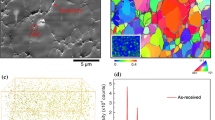Abstract
The development and recovery of damage in continuously cast aluminium alloy 6061 due to plastic deformation is investigated for different stress histories. The processes of Equal Channel Angular Extrusion and Equal Channel Angular Drawing are used to introduce damage into the specimen for a specified stress history. The amount of plastic deformation is determined by the angle between the two intersecting channels, while the stress history is varied by applying different back-pressures. The damage is related to the density, measured using Archimedes' principle.
The development of damage was observed to increase proportionally with the extent of accumulated plastic shear strain. The influence of stress history, characterised by a stress index, was found to be twofold. First, the stress index defines the intensity of the porosity development, which increases with the stress index as it changes from negative to positive values. Second, the stress index, when in the negative value region, governs the recovery process. A superimposition of high compressive stresses on the plastic shear deformation leads to a recovery of damage and an associated density increase. The kinematic equation for damage evolution is proposed and its coefficients are defined.
Similar content being viewed by others
References
Aitcin, P.C. (1971). Density and porosity measurements of solids. Journal of Materials 6, 282–294.
Atkins, A.G. and May, Y-W. (1985). Elastic and Plastic Fracture, Ellis Horwood Series Engineering Science, Chichester.
Chaboche, J.L. (1988). Continuum damage mechanics. Journal of Applied Mechanics, Transaction of the ASME 55, 59–71.
Chung, Y.S. and Abel, A. (1988). Low cycle fatigue of some aluminum alloys. ASTM Special Technical Publications 942, 94–106.
Dodd, B. and Bay, Y. (1987). Ductile Fracture and Ductility, Academic Press, Harcourt Brace Jovanovich Publishers.
Efros, V.M., Gladkovsky, S.V. and Smirnov, S.V. (1992). Phase transformation and strengthening of metastable Fe-Mn steels under high pressure. In: Proceeding of 12 International Conference in Bangalore, Recent Trends in High Pressure Research, Oxford, 725–727.
Golos, K.M. (1997). A hypothesis of cumulative damage for fatigue crack initiation and propagation. In: Proceeding of 9th International Congress on Fracture, Vol. 3. Pergamon Press, New York, 1353–1360.
Gurson, A.L. (1972). Continuum theory of ductile rupture by void nucleation and growth, Journal of Engineering Materials and Technology, Transaction of the ASME 99, 2–15.
Hill, R. (1986). The Mathematical Theory of Plasticity, Oxford University Press, Oxford, pp. 355.
Kachanov, L.M. (1986). Introduction to Continuum Damage Mechanics, Kluwer Academic Publishers, Dordrecht.
Konovalov, A.V. (1985). Mathematical model of fracture at plastic deformation defined by indentification method. Collection of Papers on Metal Forming, No. 12, 24–29 (in Russian).
Lapovok R., Cottam R., Stecher G., Deam R. and Summerville E. (2000). Investigation of ductility and damage accumulation by two stage deformation using ECAE/ECAD and tensile test. Investigations and Applications of Severe Plastic Deformation, NATO Science Series, Series 3, High Technology, Vol. 80, 303–312.
Lapovok, R., Smirnov S. and Shveykin V. (1996). Ductility defined as critical local strain. Proceedings of First Ausralasian Congress on Applied Mechanics, Melbourne, Australia, 181–185.
Lapovok R., Smirnov S. and Shveykin V. (2000). Damage mechanics for the fracture prediction of metal forming tools. International Journal of Fracture 103, 111–126.
Lemaitre, J. and Chaboche, J. (1975). A non-linear model of creep-fatigue damage cumulation and interaction, Mechanics of Visco-Plastic Media and Bodies (Edited by J. Hult), Springer-Verlag, Berlin, 291–300.
Lemaitre, J. and Dufailly, J. (1987). Damage measurements. Engineering Fracture Mechanics 28 643–661.
Manson, S.S. (1981). Thermal Stress and Low Cycle Fatigue, R.E. Krieger Publ. Co.
Segal, V.M. (1977). The Method of Material Preparation for Subsequent Working, Patent of the USSR, No. 575892.
Segal V.M., Reznikov V.I., Drobyshevskiy A.E. and Kopylov V.I. (1981). Plastic Working of Metals by Simple Shear (translation. Russian metallurgy). 99–105.
Suriadi, A.B. and Thomson, P.F. (1997). Control of deformation history for homogenizing and optimizing mechanical properties of metals. Proceedings of Australiasia-Pacific Forum on Intelligent Processing & Manufacturing of Materials, IPMM. 920–926.
Tvergaard, V. (1982). On localisation in ductile materials containing spherical voids. International Journal of Fracture 18, 237–252.
Author information
Authors and Affiliations
Rights and permissions
About this article
Cite this article
Lapovok, R. Damage evolution under severe plastic deformation. International Journal of Fracture 115, 159–172 (2002). https://doi.org/10.1023/A:1016399111787
Issue Date:
DOI: https://doi.org/10.1023/A:1016399111787




